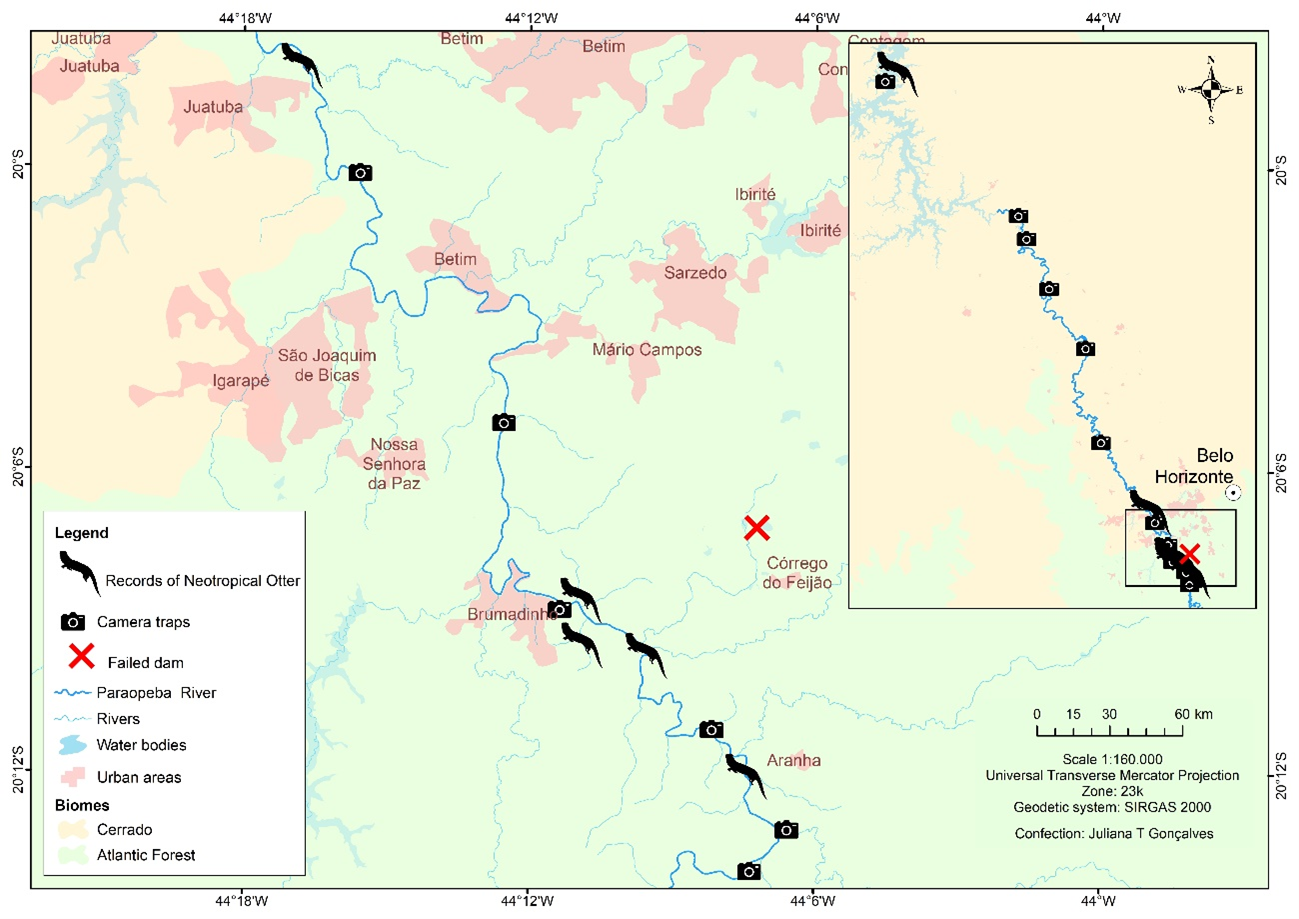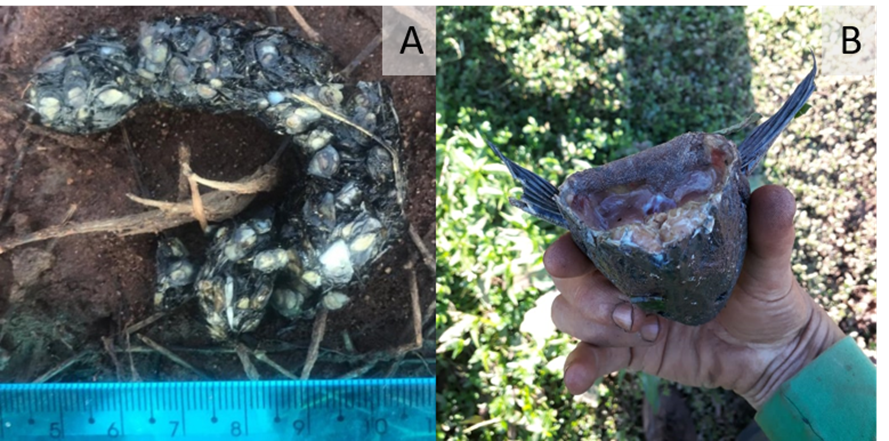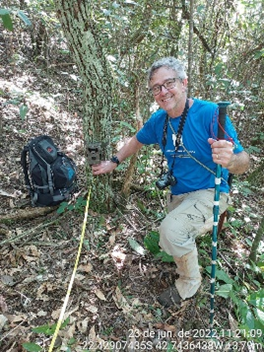IUCN/SSC Otter Specialist Group Bulletin

©IUCN/SCC Otter Specialist Group
Volume 39 Issue 3 (September 2022)
Citation: Lanna, A.M., Keesen, F. and Grelle, C.E.V. (2022). On the Current Occurrence of the Neotropical Otter (Lontra longicaudis OLFERS, 1818) in a Degraded River after a Dam Collapse, Southeast Brazil. IUCN Otter Spec. Group Bull. 39 (3): 179 - 184
On the Current Occurrence of the Neotropical Otter (Lontra longicaudis OLFERS, 1818) in a Degraded River after a Dam Collapse, Southeast Brazil
Andre M. Lanna1*, Fabiola Keesen1, and Carlos E.V. Grelle1, 2
1Programa de Pós Graduação em Ecologia, Instituto de Biologia, Universidade Federal do Rio de Janeiro, Brasil
2Departamento de Ecologia, Universidade Federal do Rio de Janeiro, Brasil
*Corresponding Author Email: andremolanna@gmail.com
(Received 13th March 2022, accepted 8th May 2022)
Abstract:The Neotropical otter (Lontra longicaudis) is a semi-aquatic predator that occurs in a wide geographic distribution in the Neotropical region, and can be used as indicator of ecosystem health. In January 2019, the Paraopeba River, which has historically been affected by anthropic activities, was impacted by the B1 iron ore tailings’ dam collapse. This might have caused severe negative impacts to the entire fauna of the region. We carried out an inventory along the Paraopeba River to assess the current occurrence of the Neotropical otter in such asystem. The results obtained indicate the occurrence of this species in the study region eight months after the damage, with records upstream and downstream of B1 dam.
Keywords: Brumadinho, dam disaster, environmental monitoring, iron ore tailings
INTRODUCTION
Otters (subfamily Lutrinae) are semiaquatic predators, with diets based on fishes, crustaceans, molluscs, small mammals, birds, amphibians, and invertebrates (Pardini, 1998; Quadros and Monteiro-Filh,o 2001; Duplaix and Savage, 2018; Rheingantz et al., 2017). Some of the thirteen otters species that occur worldwide have been considered as a model for toxicological studies due to their position as an apex predator in aquatic systems, and to their sensitivity to environmental disturbances (Ben-David et al., 2001, Crowley et al., 2018). Thus, otters can be useful for indexing levels of ecosystem health (Ben-David et al., 2001; Bowyer et al., 2003; Crowley et al., 2018), making it an ideal species for measuring environmental change, such as contamination of trace elements.
The Neotropical otter (Lontra longicaudis Olfers, 1818) occurs in a wide geographic range in the Neotropical region, including all of Brazil's biomes: Amazon, Atlantic Forest, Pantanal, Cerrado, Pampa, and Caatinga (Rheingantz et al., 2017; Rosas-Ribeiro et al., 2017). This species occurs in rivers with some degree of degradation, but its presence has been associated with rivers that have a riparian vegetation structure and clean water (Rheingantz et al., 2014; Almeida and Ramos Pereira, 2018). However, the threshold of contamination and pollution tolerance for the persistence of Neotropical otter is unknown (Rheingantz et al., 2017).
The Paraopeba River is a large river with 504 km of extension in the Minas Gerais State, Brazil, and it is a tributary of the São Francisco River. Historically, it has been impacted by several anthropic activities, particularly mining and agriculture (FEAM, 2013). Human occupation focused on mining activities in the Paraopeba basin has been intense since the beginning of the 18th century during the gold cycle in Brazil colonial period (FEAM, 2013). Therefore, the Paraopeba River is historically affected by anthropic activities that tend to compromise the quality of water bodies and on the ecology of several species that occur in this environment (e.g. Savassi et al., 2016). Despite the long and intense occupation of the Paraopeba basin, water monitoring began only in 1997, and initial monitoring reports that some indicators, such as Escherichia coli, copper and nitrate, are above the values allowed in the Brazilian standards (IGAM, 2019). This was likely related to mining, discharge of sanitary sewage, agricultural, industries, as well as erosion and silting processes (IGAM, 2019).
In addition to this historic anthropic use, in January 2019 one of the greatest mining-related disasters took place in the region. The B1 iron ore tailings’ dam, maintained by the company Vale and located about 9 km east of Brumadinho, collapse caused a mud wave of 12,106m3 of tailing, which potentially affected the Paraopeba River (Ramos et al., 2020, Parente et al., 2021). Recent water quality monitoring in the Paraopeba River revealed high levels of dissolved metals and turbity (Ramos et al., 2020), elements that can be harmful to the fauna (Jadoon and Malik, 2017). Here we present data on the occurrence of L. longicaudis following the collapse of Vale’s B1 dam.
MATERIALS AND METHODS
We performed an inventory along the Paraopeba River and nearby forest remnants (Fig. 1) aiming to investigate the occurrence of medium and large sized mammalian after the event of dam collapse and report the possible current occurrence of Neotropical otter in the Paraopeba River. We carried the inventory through non-invasive techniques (camera traps and active search) between August 2019 and January 2020. We investigated the Paraopeba basin between the stretch comprised between 30 km upstream the confluence of Córrego do Feijão (Feijão stream), near B1 iron ore tailings’ dam, and Três Marias Reservoir around 450 km downstream.

We established nine sampling points in nine regions along the area potentially affected by the collapse of the Córrego do Feijão Mine B1 tailings dam on the Paraopeba River. Three sampling points were established in control areas upstream of the confluence. Four camera traps were installed at each sampling point. Camera traps remained active for five consecutive days in both dry (Aug. 2019) and wet season (Dec. 2019 / Jan. 2020).The total effort applied in the study were 480 camera trap days. We installed camera traps preferably in native vegetation physiognomies and near to the Paraopeba River.
We also used the active search methodology (sensu Wilson et al., 1996) during 36 days based on visualizations of alive individuals, encounter of carcass, and identification of characteristics vestiges of the L. longicaudis occurrence (footprints, feces, scratches, and prey remains). We performed data collection in a random sampling along the entire area potentially affected by the collapse of the B1 tailings dam at the Córrego do Feijão.
RESULTS AND DISCUSSION
We obtained five records of L. longicaudis in the Paraopeba River sub-basin. Three records were obtained downstream of the Córrego do Feijão, which is a critical zone as it was the first place where mud has spread in the Paraopeba River after the B1 dam´s collapse. Further, two records were obtained upstream (Fig.1). Three records comprised feces identification, one record was made by camera trap photograph, and one record comprised the encounter of a prey (Loricariidae fish) remain. (Fig. 2).

Our results show that the Neotropical otters have persisted after the B1 iron ore tailings’ dam collapse, even with high levels of dissolved metals and turbidity (Ramos et al., 2020).
The occurrence of Neotropical otters in the Paraopeba River even after the B1 iron ore tailings’ dam collapse presents an opportunity to monitoring the exposure of the species to contaminants in a long-term study. Variables such as population estimation and if otters are affected by chemical contamination, including the current contamination of fishes in the Paraopeba River, should be evaluated (Parente et al., 2021). There is a cumulative effect of these chemicals, such as methyl mercury and persistent organic pollutants (e.g., organochlorine insecticides), in animals in the top of the trophic chain (Crowley et al., 2018; Huang et al., 2018). Therefore, it is essential that sentinel species such as the Neotropical otter be evaluated to assess the magnitude of contamination (Rheingantz et al., 2017; Parente et al., 2021).
Furthermore, in the last years, monitoring the L. longicaudis population through non-invasive methods such as otter feces have demonstrated to be an opportunity, as it is possible to evaluate the individual’s exposure to contamination, the diet of animals through DNA metabarcoding and demographic parameters through population genetics techniques (Latorre-Cardenas et al., 2020). Finally, a long-term study would be necessary to assess the physiological (stress markers), reproductive (hormonal levels) and population status (genetic markers) of the species in reference to the changes that have occurred in the region after the disruption of B1. Once we confirmed the persistence of L. longicaudis in Paraopepeba river, we have now an opportunity to study in depth some biological parameters useful for the assessment on conservation of such population.
ACKNOWLEDGMENTS - The authors are grateful for the valuable contribution of the researchers from COPPE/UFRJ involved in the project Environmental impacts of the Brumadinho tailings dam collapse 12 months after the disaster, mainly the ichthyology team: Adriano Hauer, Matheus O. Freitas, Thiago Occhi and Thiago Toniolo. We are also grateful to João Bianchini for the registration and photography of feces and to Marcelo Rheingantz for suggestions in a previous version of this text.
REFERENCES
Almeida, L.R., Ramos Pereira, M.J. (2018). Influence of the water quality on the occurrence of the Neotropical otter (Lontra longicaudis) (Olfers, 1818) in a human-altered river basin. Mar. Freshwater Res., 69(1): 122. https://doi.org/10.1071/MF17020
Ben-David, M., Duffy, L.K., Blundell, G.M., Bowyer, R.T. (2001). Natural exposure of coastal river otters to mercury: Relation to age, diet, and survival. Environ. Toxicol. Chem., 20(9): 1986-1992. https://doi.org/10.1002/etc.5620200917
Bowyer, R.T., Blundell, G.M., Ben-David, M., Jewett, S.C., Dean, T.A., Duffy, L.K. (2003). Effects of the Exxon Valdez oil spill on river otters: Injury and recovery of a sentinel species. Wildlife Monogra., 153: 1-53.
COPAM (Conselho Estadual de Política Ambiental) (2018). Deliberação Normativa Conjunta COPAM/CERH-MG N.º 1, de 05 de Maio de 2008.
Crowley, S.M., Hodder, D.P., Johnson, C.J., Yates, D. (2018). Wildlife health indicators and mercury exposure: A case study of river otters (Lontra canadensis) in central British Columbia, Canada. Ecol. Indic., 89: 63-73. https://doi.org/10.1016/j.ecolind.2018.01.061
Duplaix, N., Savage, M. (2018). The Global Otter Conservation Strategy. IUCN/SSC Otter Spec. Group, Salem, Oregon, USA. https://www.otterspecialistgroup.org/osg-newsite/wp-content/uploads/2018/12/IUCN-Otter-Report-DEC%2012%20final_small.pdf
FEAM. (2013). Identificação de municípios com condição crítica para a qualidade de água na bacia do rio Paraopeba. p. 41. http://www.igam.mg.gov.br/index.php?option=com_content&task=view&id=113&Itemid=173
Hoffman, D.J., Rattner, B., Jr, B., Jr, C. (2002). Handbook of ecotoxicology.1315p. https://onlinelibrary.wiley.com/doi/book/10.1002/9781444313512
Huang, A.C., Nelson, C., Elliott, J.E., Guertin, D.A., Ritland, C., Drouillard, K., Cheng, K.M., Schwantje, H.M. 2018. River otters (Lontra canadensis) “trapped” in a coastal environment contaminated with persistent organic pollutants: Demographic and physiological consequences. Environ. Pollut., 238: 306-316. https://doi.org/10.1016/j.envpol.2018.03.035
IGAM. (2019). Qualidade das águas do Rio Paraopeba, após o desastre na barragem B1 no complexo da Mina Córrego Feijão da Mineradora Vale/SA no município de Brumadinho - Minas Gerais. p. 26.
Jadoon, S., Malik, A. (2017). DNA damage by heavy metals in animals and human beings: an overview. Biochem. Pharmacol. 06: 1-8. https://doi.org/10.4172/2167-0501.1000235
Larivière, S. (1999). Lontra longicaudis. Mamm. Species. 609: 1-5. https://academic.oup.com/mspecies/article-pdf/doi/10.2307/3504393/8070530/609-1.pdf
Latorre-Cardenas, M.C., Gutiérrez-Rodríguez, C., Rico, Y. (2020). Estimating genetic and demographic parameters relevant for the conservation of the Neotropical otter, Lontra longicaudis, in Mexico. Conserv. Genet., 21(4): 719-734. https://doi.org/10.1007/s10592-020-01283-5
Pardini, R. (1998). Feeding ecology of the neotropical river otter Lontra longicaudis in an Atlantic Forest stream, south-eastern Brazil. J. Zool., 245(4): 385-391. http://dx.doi.org/10.1111/j.1469-7998.1998.tb00113.x
Parente, C.E.T., Lino, A.S., Carvalho, G.O., Pizzochero, A.C., Azevedo-Silva, C.E., Freitas, M.O., Teixeira, C., Moura, R.L., Ferreira-Filho, V.J. M., Malm, O. (2021). First year after the Brumadinho tailings’ dam collapse: Spatial and seasonal variation of trace elements in sediments, fishes and macrophytes from the Paraopeba River, Brazil. Environ. Res., 193: 110526. https://doi.org/10.1016/j.envres.2020.110526
Quadros, J., Monteiro-Filho, E.L.A. (2001). Diet of the neotropical otter, Lontra longicaudis, in an Atlantic forest area, Santa Catarina State, southern Brazil. Stud. Neotrop. Fauna E., 36(1): 15-21. https://doi.org/10.1076/snfe.36.1.15.8881
Ramos, A. M., Sabrina da Silva, L., Guimarães Lima, T., Lopes Marques, G., Medeiros Gontijo, H. (2020.) Monitoramento da qualidade da água do rio Paraopeba e entorno após o rompimento da barragem de rejeitos em Brumadinho, Minas Gerais, Brasil. Rese., Soci. Dev., 9(9). http://dx.doi.org/10.33448/rsd-v9i9.7594
Rheingantz, M.L., de Menezes, J.F.S., de Thoisy, B. (2014). Defining Neotropical otter Lontra longicaudis distribution, conservation priorities and ecological frontiers. Trop. Conserv. Sci., 7(2): 214-229. https://doi.org/10.1177/194008291400700
Rheingantz, M. L., Santiago-Plata, V. M., Trinca, C. S. (2017). The Neotropical otter Lontra longicaudis: a comprehensive update on the current knowledge and conservation status of this semiaquatic carnivore. Mammal Ver., 47(4): 291-305. https://doi.org/10.1111/mam.12098
Rosas-Ribeiro, P. F., Ranulpho, R., Venticinque, E. (2017). New records and update on the geographic distribution of Lontra longicaudis (Olfers, 1818) (Carnivora: Mustelidae) in Seasonally Dry Tropical Forests of northeastern Brazil. Check List, 13(3): 2108. http://doi.org/10.15560/13.3.2108
Savassi, L.A., Arantes, F.P., Gomes, M.V.T., Bazzoli, N. (2016). Heavy metals and histopathological alterations in Salminus franciscanus (Lima and Britski, 2007) (Pisces: Characiformes) in the Paraopeba River, Minas Gerais, Brazil. Bull Environ. Contam. Toxicol. 96, 478-483. https://doi.org/10.1007/s00128-016-1732-8
Walsh, C. and Wilson, T.D. (1995). Information Behaviour: An Interdisciplinary Perspective. London: British Library Research and Development Department (BLRDD Report No. 10) http://www.informationr.net/tdw/publ/infbehav/cont.html
Résumé: Sur l’Occurrence Actuelle de la Loutre Néotropique (Lontra Longicaudis Olfers, 1818) dans une Rivière Dégravée après l’Effondrement d’un Barrage, Sud-Est du Brésil
La loutre néotropicale (Lontra longicaudis) est un prédateur semi-aquatique présent dans une large distribution géographique dans la région néotropicale, et peut être utilisée comme indicateur de la santé des écosystèmes. En janvier 2019, la rivière Paraopeba, qui a historiquement été affectée par des activités anthropiques, a été touchée par l’effondrement des résidus de minerai de fer B1. Cela pourrait avoir causé de graves impacts négatifs sur l’ensemble de la faune de la région. Nous avons réalisé un inventaire le long de la rivière Paraopeba pour évaluer la présence actuelle de la loutre néotropicale dans ce système. Les résultats obtenus indiquent la présence de cette espèce dans la région étudiée huit mois après les dégâts, avec des enregistrements en amont et en aval du barrage B1.
Revenez au dessus
Resumen: Sobre la Presencia Actual de la Nutria Neotropical (Lontra longicaudis OLFERS, 1818) en un Río Degradado después del Colapso de una Presa, Sureste de Brasil
La nutria neotropical (Lontra longicaudis) es un depredador semiacuático que ocurre en una amplia distribución geográfica en la región neotropical, y puede ser utilizada como indicador de la salud del ecosistema. En enero de 2019, el río Paraopeba, históricamente afectado por actividades antrópicas, sufrió el impacto del derrumbe de los relaves de hierro B1. Esto puede haber causado graves impactos negativos a toda la fauna de la región. Realizamos un inventario a lo largo del río Paraopeba para evaluar la ocurrencia actual de la nutria neotropical en dicho sistema. Los resultados obtenidos indican la presencia de esta especie en la región de estudio ocho meses después del daño, con registros aguas arriba y aguas abajo de la presa B1.
Vuelva a la tapa


